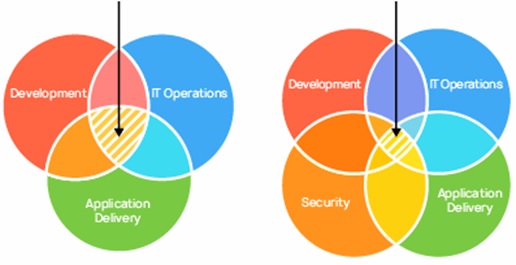DevSecOps
DevSecOps—short for development, security, and operations—automates the integration of security at every phase of the software development lifecycle, from initial design through integration, testing, deployment, and software delivery.
DevSecOps represents a natural and necessary evolution in the way development organizations approach security. [1] In the past, security was 'tacked on' to software at the end of the development cycle (almost as an afterthought) by a separate security team and was tested by a separate quality assurance (QA) team.
This was manageable when software updates were released just once or twice a year. But as software developers adopted Agile and DevOps practices, aiming to reduce software development cycles to weeks or even days, [2] the traditional 'tacked-on' approach to security created an unacceptable bottleneck.
DevSecOps integrates application and infrastructure security seamlessly into Agile and DevOps processes and tools. It addresses security issues as they emerge, when they're easier, faster, and less expensive to fix (and before they are put into production). Additionally, DevSecOps makes application and infrastructure security a shared responsibility of development, security, and IT operations teams, rather than the sole responsibility of a security silo. It enables “software, safer, sooner”—the DevSecOps motto–by automating the delivery of secure software without slowing the software development cycle as shown in figure 1.

Figure 1. DevSecOps Process
Three key things make a real [3] DevSecOps environment:
- Security testing is done by the development team.
- Issues found during that testing is managed by the development team.
- Fixing those issues stays within the development team.
Benefits of DevSecOps
The two main benefits of DevSecOps are speed and security. [4] Development teams deliver better, more-secure code faster, and, therefore, cheaper.
“The purpose and intent of DevSecOps is to build on the mindset that everyone is responsible for security with the goal of safely distributing security decisions at speed and scale to those who hold the highest level of context without sacrificing the safety required,” describes Shannon Lietz, co-author of the “DevSecOps Manifesto.”
Rapid, cost-effective software delivery
When software is developed in a non-DevSecOps environment, security problems can lead to huge time delays. Fixing the code and security issues can be time-consuming and expensive. The rapid, secure delivery of DevSecOps saves time and reduces costs by minimizing the need to repeat a process to address security issues after the fact.
This becomes more efficient and cost-effective since integrated security cuts out duplicative reviews and unnecessary rebuilds, resulting in more secure code.
Improved, proactive security
DevSecOps introduces cybersecurity processes from the beginning of the development cycle. Throughout the development cycle, the code is reviewed, audited, scanned, and tested for security issues. These issues are addressed as soon as they are identified. Security problems are fixed before additional dependencies are introduced. Security issues become less expensive to fix when protective technology is identified and implemented early in the cycle.
Additionally, better collaboration between development, security, and operations teams improves an organization’s response to incidences and problems when they occur. [5] DevSecOps practices reduce the time to patch vulnerabilities and free up security teams to focus on higher value work. These practices also ensure and simplify compliance, saving application development projects from having to be retrofitted for security.
Accelerated security vulnerability patching
A key benefit of DevSecOps is how quickly it manages newly identified security vulnerabilities. As DevSecOps integrates vulnerability scanning and patching into the release cycle, the ability to identify and patch common vulnerabilities and exposures (CVE) is diminished. This limits the window a threat actor has to take advantage of vulnerabilities in public-facing production systems.
Automation compatible with modern development
Cybersecurity testing can be integrated into an automated test suite for operations teams if an organization uses a continuous integration/continuous delivery pipeline to ship their software. Automation of security checks depends strongly on the project and organizational goals. Automated testing can ensure incorporated software dependencies are at appropriate patch levels, and confirm that software passes security unit testing. Plus, it can test and secure code with static and dynamic analysis before the final update is promoted to production.
A repeatable and adaptive process
As organizations mature, their security postures mature. DevSecOps lends itself to repeatable and adaptive processes. This ensures security is applied consistently across the environment, as the environment changes and adapts to new requirements. A mature implementation of DevSecOps will have a solid automation, configuration management, orchestration, containers, immutable infrastructure, and even serverless compute environments.
References:
- https://www.redhat.com/en/topics/devops/what-is-devsecops
- https://www.devsecops.org/
- https://www.ibm.com/in-en/cloud/learn/devsecops
- https://www.forcepoint.com/cyber-edu/devsecops
- https://www.csoonline.com/article/3245748/what-is-devsecops-developing-more-secure-applications.html
Cite this article:
Vinotha D (2021), DevSecOps, AnaTechMaz, pp 5















